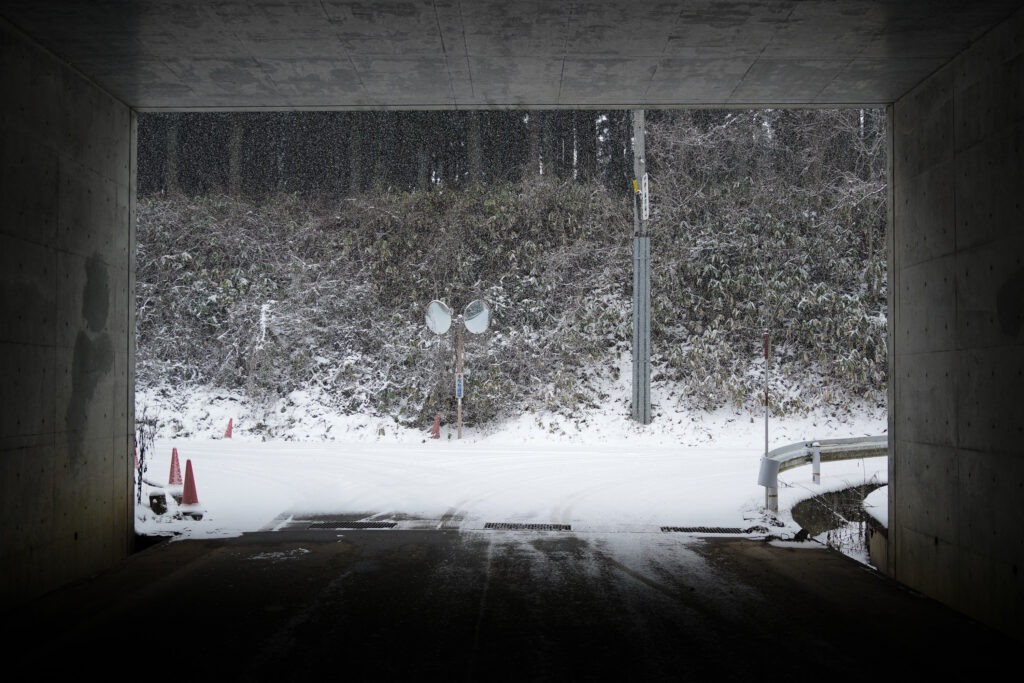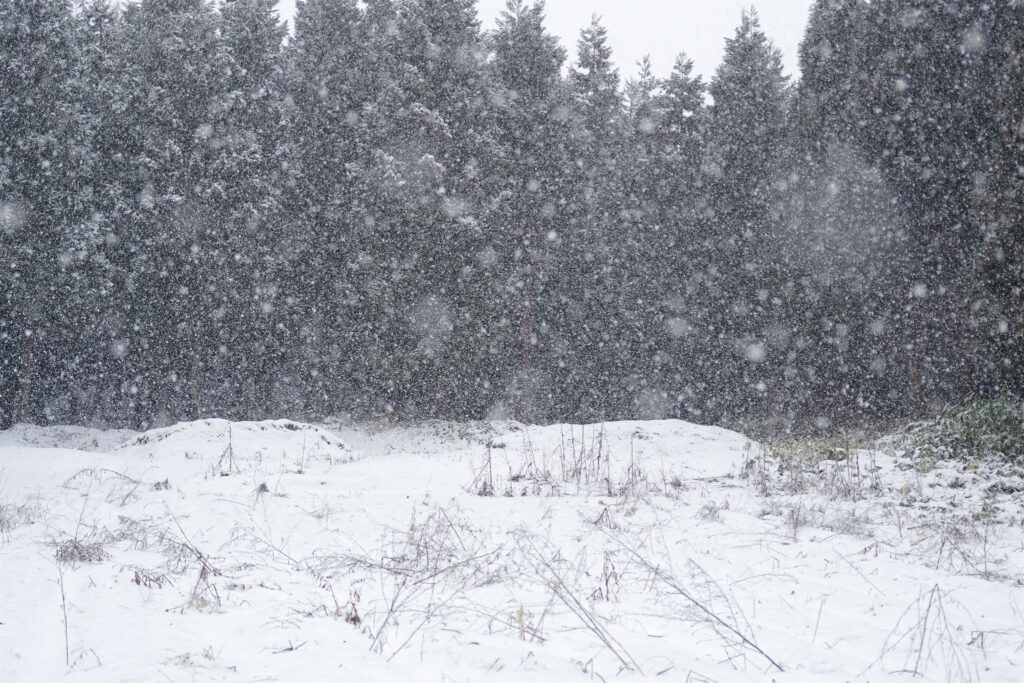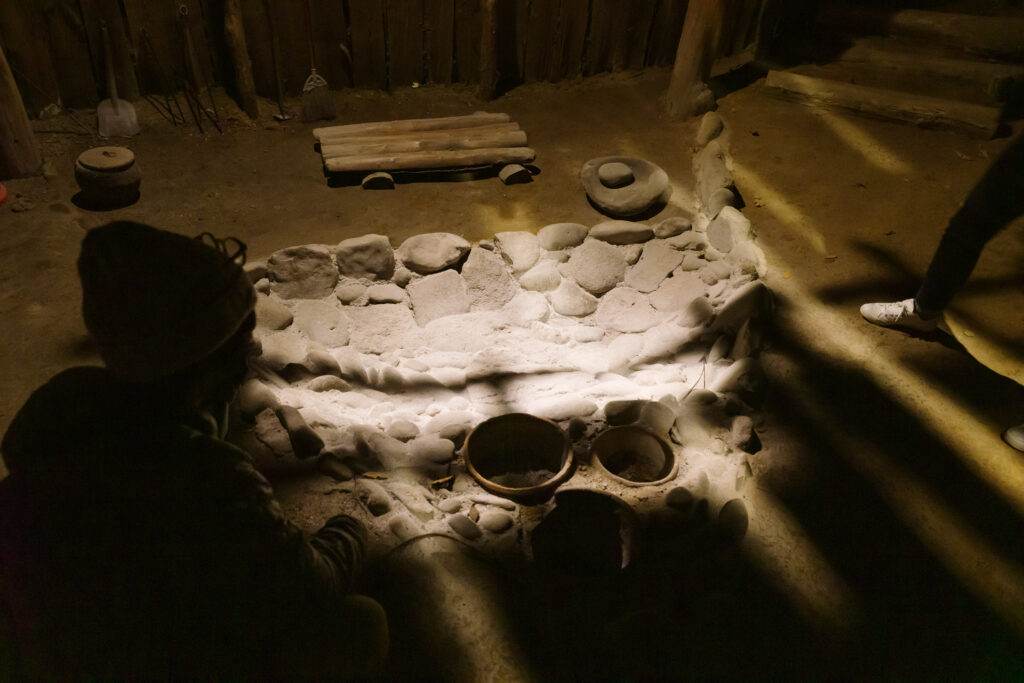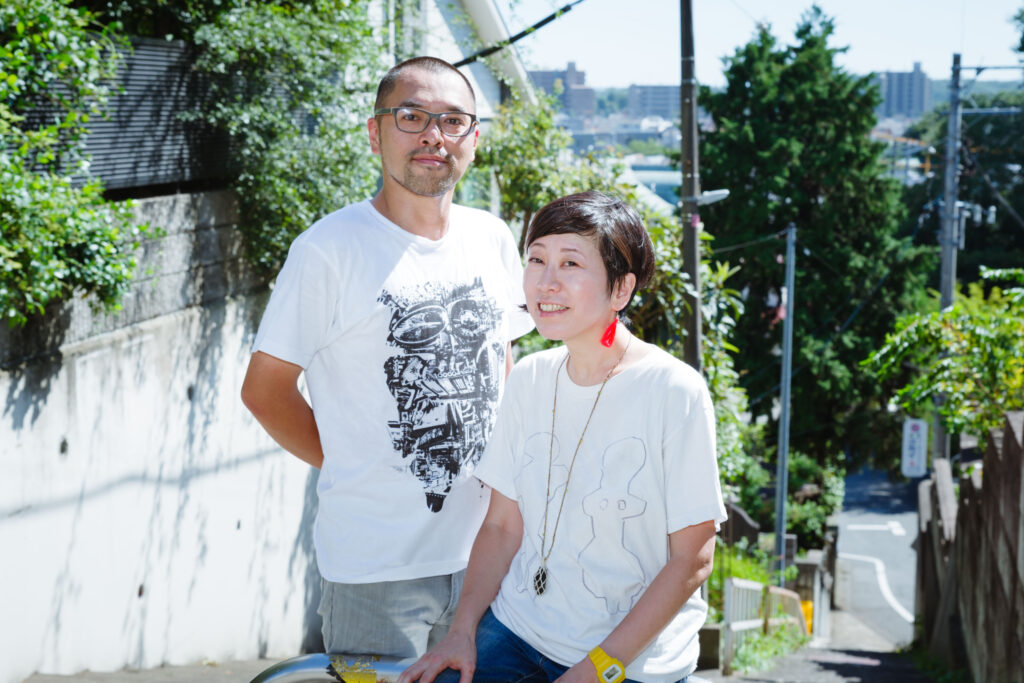- JAPANESE
- LANGUAGE
X
 THAT IS GOOD
THAT IS GOOD
Reading Part 1
*’Fukushiki-ro’ is a large-size fireplace constructed from an arrangement of large riverbed stones.
It was the morning of the following day when I visited the Hoshojiri Site. The Aizu Basin was filled with fresh white snow that had fallen only yesterday. We walked through a peaceful landscape dotted with fields and forests. The terrain, which was formed by the volcanic eruption of Bandai, was full of ups and downs, and the car went up and down several times. We stopped at a tourist farm building on a hill to ask for directions, but were stunned to find that the weather had turned to snow by the time we got out. This made it impossible to get a shot of Mt. Bandai and the ruins. As we turned at the fork we had been told to take in the incessant heavy snow, we could see the highway beyond the rows of plastic greenhouses with only their frameworks. This area is the Hoshojiri Site.
We parked our car under a highway pier and took a parallel side road to the right, which eventually led us to an open area with a pond. Perhaps there was a small field, but it was covered with a blanket of white snow, so I could not see what was there. As we entered the surrounding coniferous forest, we saw a number of large boulders exposed among the trees, perhaps blown in by the eruption of Bandai-san. As we descended the path, the forest soon ended and we came to an expanse of fields. Bandai, which was supposed to be visible there, had faded to white.

Naturally, I think of the Jomon people who spent snow days. The Japan Sea side climate, in which cold air blowing down from the continent collides with moist air over the Sea of Japan and causes large amounts of snow to fall, had already begun by this time. Houses would have to be solidly built so as not to be crushed by the weight of such wet snow, and furs would be necessary to protect against the cold.
What did they do about food? Winter is said to be a good season for hunting because the leaves fall off the trees, but we need to preserve nuts and rhizomes as a source of energy. We also need to secure firewood to burn during the winter. —-Perhaps the people of Hoshojiri community were cooperating with each other to do all of this. Otherwise, life would not have continued for a thousand years in a land of such heavy snowfall.
We went back to the pond area and tried to make something somewhat like a clay figurine out of snow. Such a simple game, but quite fun. I wonder if the children of Hoshojiri community also played this kind of game.
After that, I headed to Aizuwakamatsu, where I had hot Kitakata ramen at a ramen restaurant without a sign, which curator K told me about, and bought some local Aizu sake at a sake select store that a sake-loving friend told me about before heading home.

After my trip to Fukushima, I am writing about the Fukushiki-ro in Tokyo. In the end, I could not figure out what it was all about. It was like a system kitchen, but never sure if it was useful or not. I had a feeling the answer lay elsewhere. Then I remembered how I felt when I saw the Fukushiki-ro in Mahoron’s restored residence.
I have been in pit dwellings many times before and have been allowed to hold events in pit dwellings. However, I may have never felt as indescribably rich as I did then. I was excited to see what I could create if I built a fire here. It was a feeling that could not have happened when I saw a simple stone hearth.
On the other hand, the dense arrangement of stones of various sizes along gently curving lines seemed bizarre. It was similar to the feeling of being overwhelmed by a stone wall piled with stones of various shapes. The Fukushiki-ro, which is a collection of stones, has a unique atmosphere.
Stones hold a profound world. As in the case of shrines with shimenawa (sacred straw ropes) made of pegmatite, people in ancient times regarded stones as sacred rocks on which invisible spirits and souls dwelled. Especially hard and strong stones will remain for generations to come, even after one’s death. The fukushiki-ro is a sublimation of the eternal nature of stone.

Importantly, there are earthenware vessels embedded in the stone. Earthenware makes food easier to eat. The establishment of cooking techniques such as removing scum and boiling food was accomplished by earthenware, which enabled omnivores to eat fish, shellfish, meat, a wide variety of wild plants, nuts, and mushrooms. Earthenware is like a magical device that connects the natural world and the human world, because things that are bitter and inedible as they are can be eaten when boiled in earthenware. In other words, no matter how much the patterns are stripped away, earthenware remains a device that connects life between nature and humankind. A Fukushiki-ro is a sacred earthenware vessel embedded in a structure of stone, a hard universal material. In other words, the earthenware and the stone are fused together for added power.
For those who understood well that the acquisition of food was directly connected to their lives, there was nothing more precious than for the natural world to be filled with abundance. Therefore, people pray. They decorated earthenware beautifully to convey their thoughts to the natural world. In a sense, the patterns on Jomon earthenware are an expression of man’s intentions toward the unspeaking natural world and a means of communication. In a sense, the patterns on Jomon earthenware are an expression of human intention toward the unspeaking natural world and a means of communication. If we look at the patterns in this way, the fact that the appearance of earthenware in this region became simpler with the advent of the fukushiki-ro is simply a change in the way of communication. In other words, it can be said that the symbol of affluence, which had been carried by the decoration of earthenware, has been transferred to the fukushiki-ro.

I think the furnace in a pit dwelling is like the heart of the house. Even today, we describe the loss of liveliness and loneliness as “the fire seems to have gone out” The crushed pit dwellings we saw at the Harase-Uwahara Ruins in Nihonmatsu City gave us a sense of desolation, as if the fire had truly gone out.. The crushed pit dwellings we saw at the Harase-Uehara site in Nihonmatsu City gave us a sense of desolation, as if the fire had truly gone out. Without fire, the pit dwellings would become dens of mold, insects, and animals, and eventually decay. Therefore, the furnace of the house must keep the fire burning so that the house will not die. Fire is also a sacred entity that connects life.
In a sense, the compound furnace is a powerful trinity of devices (units) that fuse stone, earthenware, and fire. People implemented a kind of sanctuary in each house to connect the natural world and the human world so that affluence would continue and misfortune would not occur. The Fukushiki-ro then spread to various parts of eastern Japan, especially in the southern Tohoku region, at the end of the middle Jomon period. I see there a large network of people who were “passionate about stones”.
Of course, what a Fukushiki-ro is has never been academically clarified. What is certain, however, is that this passion for stone did not cease even after the demise of the fukushiki-ro. In the late Jomon period, the era of the huge annular stone blocks, in which stones were arranged in concentric circles, began in the Tohoku and Hokkaido regions. One wonders how long this passion for stones will continue. Perhaps, like the pegmatite shrines, it continues quietly into the present day?
Tomoko Kusakari : Text, Yoshiaki Hirokawa : Photo

nawa to yajiri
(it means “Rope and Arrowhead”)
A unit for exploring the Jomon by Tomoko Kusakari (writing) and Yoshiaki Hirokawa (photography).
In addition to working as members of the NPO Jomonism, they also travel around Japan visiting Jomon ruins, archaeological sites and local museums, exploring the prehistoric values that can be deciphered from the forms and environments of the Jomon.
http://nawatoyajiri.com